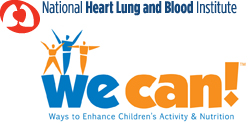


The United States is facing a potentially devastating public health crisis of overweight and obesity. Nearly one-third of all adults are now classified as obese, a figure that has more than doubled over the last 30 years.
Since 1980, obesity has more than doubled among children ages 2-5 and more than tripled among youth ages 6-11 and adolescents ages 12-19.
Recent data published in the Journal of the American Medical Association (JAMA) in May 2008 continue to underscore the staggering effect the epidemic has had on children.
According to this study, the most recent National Health and Nutrition Examination Surveys (2003-6) indicate that 16.3 percent of children ages 2-19 years are overweight. An additional 15.6 percent are considered at risk of becoming overweight.
For more on childhood overweight research, visit Learn It.
Addressing the Issue
The National Heart, Lung, and Blood (NHLBI) Obesity Education Initiative has a population-based strategy as part of its mandate. This strategy’s focus is on the prevention of overweight and obesity in both children and adults through community action, strategic partnership development and national outreach.
To help define the unique niche and program parameters for dealing with childhood obesity prevention, NHLBI conducted several research and planning activities, including:
The outcome of these activities was a program that uniquely targets parents and families as a primary group for influencing youth audiences. The Institute of Medicine's Committee on Prevention of Obesity in Children and Youth reviewed and praised this approach that translates and communicates intervention science for youth, parents, and families.
Implementing a Solution
The National Institutes of Health (NIH) program, launched by HHS Secretary Leavitt and other leading public health officials on June 1, 2005, combines materials development and dissemination, community involvement, media outreach, national partnerships, and program assessment.
Materials. NIH has developed science-based materials appropriate for families and communities, including a new federally reviewed curriculum that teaches parents and caregivers about the "do's and don'ts" of "Energy Balance;" a community toolkit for program planners with steps offer We Can! in their communities; and a program Web site that offers the program materials to the public. Learn more about We Can! materials and resources.
Community Involvement. A primary element of We Can! is community involvement. We Can! provides communities with a flexible, turn-key, and evidence-based program that is currently running in 891 community sites in the United States, Australia, Bangladesh, Canada, Fiji, Greece, India, Nigeria, the Northern Mariana Islands, the Philippines, Puerto Rico, and Uganda. The sites are diverse and include hospitals and health systems, public health departments, YMCAs, faith-based organizations, schools, universities, park and recreation departments, and many more. See a complete list of We Can! community sites.
Partnerships. Another important part of the program is We Can! partnerships. Since its launch, We Can! has created partnerships with over 25 national organizations that help spread the messages to a wider audience. In addition, numerous Fortune 500 corporations are either implementing program activities or in discussion with NIH to leverage corporate America’s resources and reach for a better future for our children. Learn more about We Can! partners.
Media Outreach. The program has received attention through national and local print, radio, online and television placements that are estimated to have reached millions of viewers and readers; launching We Can! messages into the lives of the families across the nation. Learn more about We Can! media.
Program Assessment. When the program completed its first year of activities, NIH sought to better understand the program strengths and weaknesses by conducting outcome and process evaluation of 14 Intensive Community Sites that ran We Can! Initial assessment of the results of the parents program indicated improvements in a variety of knowledge, attitude, and behavioral intent measures for parents, including energy balance, portion size, physical activity, and screen time.
Youth participating in We Can! evidence-based curricula also showed gains, improving on measures including food knowledge and attitudes, healthy eating behaviors, physical activity attitudes, and screen-time behaviors. These 14 communities reached an estimated 77,000 attendees at community events and forged partnerships with over 90 local organizations. Based on this initial assessment, We Can! Community Sites across the country appear motivated and equipped to help NIH prevent families childhood overweight and obesity. Learn more about the We Can! Intensive Sites.
Learn More about We Can! in these General Resources
The following resources provide an overview and background information about the We Can! program. You may need to download Adobe Reader, Flash Player, or Real Player.
We Can! Strategy Development Workshop Report (PDF, 2.64 MB): Summary of two-day NHLBI Strategy Development Workshop.
We Can! Fact Sheet (PDF, 642 KB): Two page overview of We Can! includes background information, materials and resources, and information on joining the We Can! program.
We Can! Video (Real Media): An 8-minute video that highlights the program and the importance of preventing overweight and obesity for families.
We Can! Flash Animation (Adobe Flash): A 60- second animation that highlights the importance of preventing overweight and obesity for families.
We Can! Program Brochure (PDF, 240 KB): Provides basic program information and how families can take action to improve their health by maintaining a healthy weight.
We Can! Progress Report (PDF, 4 MB): An initial assessment of the program as it was implemented in 14 community sites, including the methods and results of each implementation.
We Can! Partner Presentation (PDF, 1 MB): PDF version of a PowerPoint presentation that explain the various components of the We Can! program.
We Can!™ is a trademark of the U.S. Department of Health and Human Services.